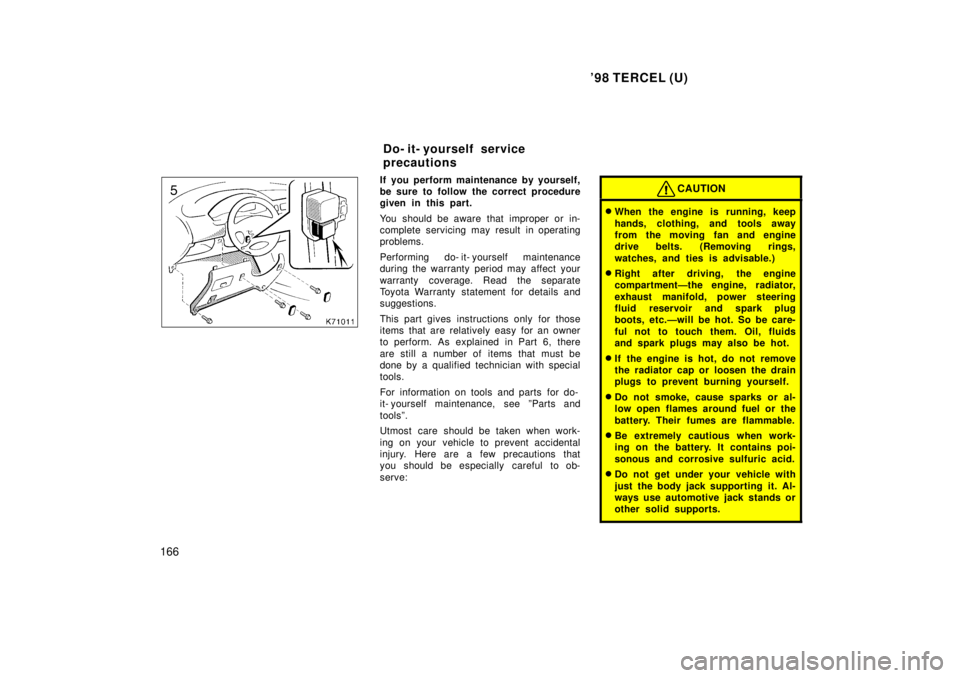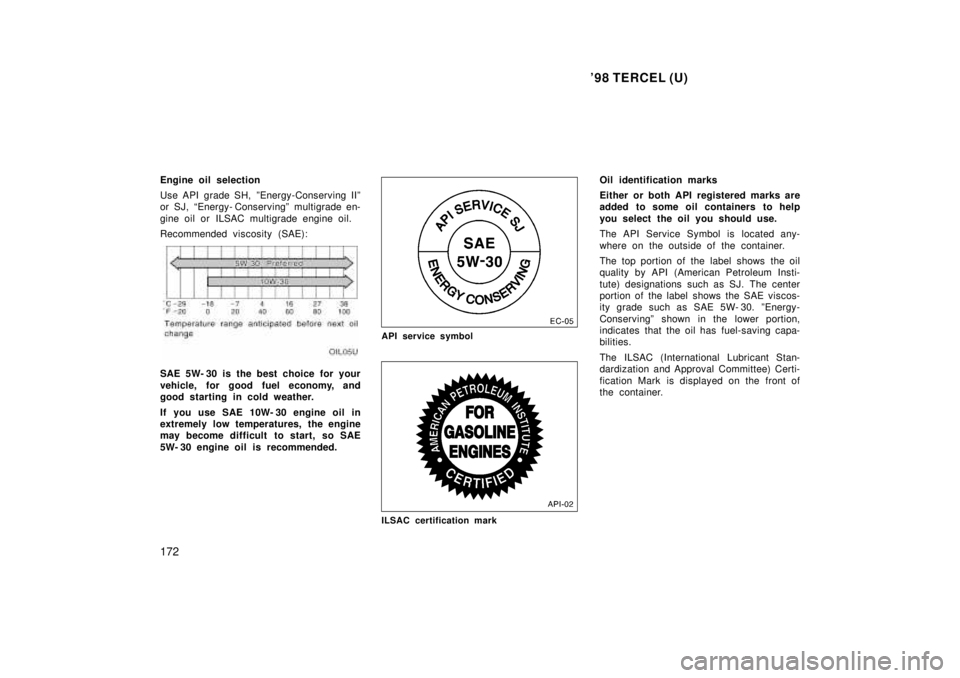Page 162 of 194

'98 TERCEL (U)
166
If you perform maintenance by yourself,
be sure to follow the correct procedure
given in this part.
You should be aware that improper or in-
complete servicing may result in operating
problems.
Performing do- it- yourself maintenance
during the warranty period may affect your
warranty coverage. Read the separate
Toyota Warranty statement for details and
suggestions.
This part gives instructions only for those
items that are relatively easy for an owner
to perform. As explained in Part 6, there
are still a number of items that must be
done by a qualified technician with special
tools.
For information on tools and parts for do-
it- yourself maintenance, see ºParts and
toolsº.
Utmost care should be taken when work-
ing on your vehicle to prevent accidental
injury. Here are a few precautions that
you should be especially careful to ob-
serve:CAUTION
� When the engine is running, keep
hands, clothing, and tools away
from the moving fan and engine
drive belts. (Removing rings,
watches, and ties is advisable.)
� Right after driving, the engine
compartmentÐthe engine, radiator,
exhaust manifold, power steering
fluid reservoir and spark plug
boots, etc.Ðwill be hot. So be care-
ful not to touch them. Oil, fluids
and spark plugs may also be hot.
� If the engine is hot, do not remove
the radiator cap or loosen the drain
plugs to prevent burning yourself.
� Do not smoke, cause sparks or al-
low open flames around fuel or the
battery. Their fumes are flammable.
� Be extremely cautious when work-
ing on the battery. It contains poi-
sonous and corrosive sulfuric acid.
� Do not get under your vehicle with
just the body jack supporting it. Al-
ways use automotive jack stands or
other solid supports.
Do- it- yourself service
precautions
Page 168 of 194

'98 TERCEL (U)
172
Engine oil selection
Use API grade SH, ºEnergy-Conserving IIº
or SJ, Energy- Conservingº multigrade en-
gine oil or ILSAC multigrade engine oil.
Recommended viscosity (SAE):
SAE 5W- 30 is the best choice for your
vehicle, for good fuel economy, and
good starting in cold weather.
If you use SAE 10W- 30 engine oil in
extremely low temperatures, the engine
may become difficult to start, so SAE
5W- 30 engine oil is recommended.
API service symbol
ILSAC certification mark
Oil identification marks
Either or both API registered marks are
added to some oil containers to help
you select the oil you should use.
The API Service Symbol is located any-
where on the outside of the container.
The top portion of the label shows the oil
quality by API (American Petroleum Insti-
tute) designations such as SJ. The center
portion of the label shows the SAE viscos-
ity grade such as SAE 5W- 30. ºEnergy-
Conservingº shown in the lower portion,
indicates that the oil has fuel-saving capa-
bilities.
The ILSAC (International Lubricant Stan-
dardization and Approval Committee) Certi-
fication Mark is displayed on the front of
the container.
Page 171 of 194

'98 TERCEL (U)175
c. Reinstall the filler cap.
d. Remove the filler cap again and look at
the fluid level. If the fluid is cold, the
level should be in the ºCOLDº range on
the dipstick. Similarly, if it is hot, the fluid
level should be in the ºHOTº range. If the
level is at the low side of either range,
add automatic transmission fluidDEXRON
�II or III to bring the level within
the range.
e. After replacing the filler cap, visually
check the steering box case, vane pump
and hose connections for leaks or dam-age.
CAUTION
The reservoir tank may be hot so be
careful not to burn yourself.
NOTICE
Avoid overfilling, or the power steer-
ing could be damaged.
Checking tire pressure
Keep your tire pressures at the proper
level.
The recommended cold tire pressures, tire
size and the vehicle capacity weight are
given in Part 8. They are also on the tire
pressure label as shown.
You should check the tire pressures every
two weeks, or at least once a month. And
do not forget the spare!
Incorrect tire pressure can reduce tire
life and make your vehicle less safe to
drive. Low tire pressure results in excessive
wear, poor handling, reduced fuel econo-
my, and the possibility of blowouts from
overheated tires. Also, low tire pressure
can cause poor sealing of the tire bead.
If the tire pressure is excessively low,
there is the possibility of w
heel deforma-
tion and/or tire separation.
High tire pressure produces a harsh ride,
handling problems, excessive wear at the
center of the tire tread, and a greater
possibility of tire damage from road haz-
ards.
If a tire frequently needs ref illing, have it
checked by your Toyota dealer.
The following instructions for checking
tire pressure should be observed:
� The pressure should be checked only
when the tires are cold. If your ve-
hicle has been packed for at least 3
hours and has not been driven for
more than 1.5 km or 1 mile since, you
will get an accurate cold tire pressure
reading.
� Always use a tire pressure gauge.
The appearance of a tire can be mis-
leading. Besides, tire pressures that
are even just a few pounds off can
degrade handling and ride.
Page 187 of 194
'98 TERCEL (U)191
Part 8
SPECIFICATIONS �
Dimensions and weight
�Engine
�Fuel
�Service specifications
�Ti r es
�Fuses
Dimensions and weight
Overall length mm (in.) 4130 (162.6)
Overall width mm (in.) 1660 ( 65.4)
Overall height mm (in.) 1375 ( 54.1)
*
Wheelbase mm (in.) 2380 ( 93.7)
Front tread mm (in.) 1400 ( 55.1)
Rear tread mm (in.) 1395 ( 54.9)
Vehicle capacity weight
(occupants + luggage) kg (lb.) 352 (775)
* : Unladen vehicle Engine
Model:
5E- FE
Type: 4 cylinder in line, 4 cycle, gasoline
Bore and stroke, mm (in.): 74.0 y 87.0 (2.91 y 3.43)
Displacement, cm 3
(cu. in.):
1497 (91.3)
Page 188 of 194

'98 TERCEL (U)
192
Fuel
Fuel type:
Unleaded gasoline, Octane Rating 87
(Research Octane Number 91) or higher
Fuel tank capacity, L (gal., Imp. gal.): 45 (11.9, 9.9) Service specifications
ENGINE
Valve clearance (engine cold), mm (in.):
Intake 0.15Ð0.25 (0.006Ð0.010)
Exhaust 0.31Ð0.41 (0.012Ð0.016)
Spark plug type: DENSO K16TR11
NGK BKR5EKB11
Spark plug gap, mm (in.): 1.1 (0.043)
Drive belt tension measured with Borroughs
drive belt tension gauge No.BT- 33- 73F
(used belt), Ibf: 100 � 20
ENGINE LUBRICATION
Oil capacity (drain and refill), L (qt., Imp. qt.):
With filter 2.8 (3.0, 2.5)
Without filter 2.6 (2.7, 2.3)
Oil grade: API grade SH, ºEnergy-Conserving IIº or
SJ, Energy- Conservingº multigrade en-
gine oil or ILSAC multigrade engine oil
is recommended. Recommended oil viscosity (SAE):
COOLING SYSTEM
Total capacity, L (qt., Imp. qt.):
Automatic transmission Vehiecles sold in Puerto Rico
4.8 (5.1, 4.2)
Vehiecles sold outside Puerto Rico 5.3 (5.6, 4.7)
Manual transmission 4.9 (5.2, 4.3)
Coolant type: With ethylene- glycol antifreeze
(Do not use alcohol type.)